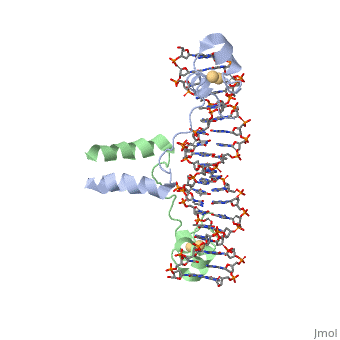Sandbox Reserved 1686
From Proteopedia
(Difference between revisions)
| Line 1: | Line 1: | ||
{{Gal4 practice page}}<!-- PLEASE ADD YOUR CONTENT BELOW HERE --> | {{Gal4 practice page}}<!-- PLEASE ADD YOUR CONTENT BELOW HERE --> | ||
| - | <StructureSection load=' | + | ==DNA RECOGNITION BY GAL4: STRUCTURE OF A PROTEIN/DNA COMPLEX== |
| - | + | <StructureSection load='1d66' size='340' side='right'caption='[[1d66]], [[Resolution|resolution]] 2.70Å' scene=''> | |
| - | + | == Structural highlights == | |
| - | + | <table><tr><td colspan='2'>[[1d66]] is a 4 chain structure with sequence from [https://en.wikipedia.org/wiki/Atcc_18824 Atcc 18824]. Full crystallographic information is available from [http://oca.weizmann.ac.il/oca-bin/ocashort?id=1D66 OCA]. For a <b>guided tour on the structure components</b> use [https://proteopedia.org/fgij/fg.htm?mol=1D66 FirstGlance]. <br> | |
| + | </td></tr><tr id='ligand'><td class="sblockLbl"><b>[[Ligand|Ligands:]]</b></td><td class="sblockDat" id="ligandDat"><scene name='pdbligand=CD:CADMIUM+ION'>CD</scene></td></tr> | ||
| + | <tr id='resources'><td class="sblockLbl"><b>Resources:</b></td><td class="sblockDat"><span class='plainlinks'>[https://proteopedia.org/fgij/fg.htm?mol=1d66 FirstGlance], [http://oca.weizmann.ac.il/oca-bin/ocaids?id=1d66 OCA], [https://pdbe.org/1d66 PDBe], [https://www.rcsb.org/pdb/explore.do?structureId=1d66 RCSB], [https://www.ebi.ac.uk/pdbsum/1d66 PDBsum], [https://prosat.h-its.org/prosat/prosatexe?pdbcode=1d66 ProSAT]</span></td></tr> | ||
| + | </table> | ||
== Function == | == Function == | ||
| + | [[https://www.uniprot.org/uniprot/GAL4_YEAST GAL4_YEAST]] This protein is a positive regulator for the gene expression of the galactose-induced genes such as GAL1, GAL2, GAL7, GAL10, and MEL1 which code for the enzymes used to convert galactose to glucose. It recognizes a 17 base pair sequence in (5'-CGGRNNRCYNYNCNCCG-3') the upstream activating sequence (UAS-G) of these genes. | ||
| + | == Evolutionary Conservation == | ||
| + | [[Image:Consurf_key_small.gif|200px|right]] | ||
| + | Check<jmol> | ||
| + | <jmolCheckbox> | ||
| + | <scriptWhenChecked>; select protein; define ~consurf_to_do selected; consurf_initial_scene = true; script "/wiki/ConSurf/d6/1d66_consurf.spt"</scriptWhenChecked> | ||
| + | <scriptWhenUnchecked>script /wiki/extensions/Proteopedia/spt/initialview01.spt</scriptWhenUnchecked> | ||
| + | <text>to colour the structure by Evolutionary Conservation</text> | ||
| + | </jmolCheckbox> | ||
| + | </jmol>, as determined by [http://consurfdb.tau.ac.il/ ConSurfDB]. You may read the [[Conservation%2C_Evolutionary|explanation]] of the method and the full data available from [http://bental.tau.ac.il/new_ConSurfDB/main_output.php?pdb_ID=1d66 ConSurf]. | ||
| + | <div style="clear:both"></div> | ||
| + | <div style="background-color:#fffaf0;"> | ||
| + | == Publication Abstract from PubMed == | ||
| + | A specific DNA complex of the 65-residue, N-terminal fragment of the yeast transcriptional activator, GAL4, has been analysed at 2.7 A resolution by X-ray crystallography. The protein binds as a dimer to a symmetrical 17-base-pair sequence. A small, Zn(2+)-containing domain recognizes a conserved CCG triplet at each end of the site through direct contacts with the major groove. A short coiled-coil dimerization element imposes 2-fold symmetry. A segment of extended polypeptide chain links the metal-binding module to the dimerization element and specifies the length of the site. The relatively open structure of the complex would allow another protein to bind coordinately with GAL4. | ||
| - | + | DNA recognition by GAL4: structure of a protein-DNA complex.,Marmorstein R, Carey M, Ptashne M, Harrison SC Nature. 1992 Apr 2;356(6368):408-14. PMID:1557122<ref>PMID:1557122</ref> | |
| - | + | From MEDLINE®/PubMed®, a database of the U.S. National Library of Medicine.<br> | |
| - | + | </div> | |
| - | == | + | <div class="pdbe-citations 1d66" style="background-color:#fffaf0;"></div> |
| - | + | ==See Also== | |
| + | *[[Gal3-Gal80-Gal4|Gal3-Gal80-Gal4]] | ||
| + | *[[Hydrogen in macromolecular models|Hydrogen in macromolecular models]] | ||
| + | == References == | ||
| + | <references/> | ||
| + | __TOC__ | ||
| + | </StructureSection> | ||
| + | [[Category: Atcc 18824]] | ||
| + | [[Category: Large Structures]] | ||
| + | [[Category: Carey, M]] | ||
| + | [[Category: Harrison, S C]] | ||
| + | [[Category: Marmorstein, R]] | ||
| + | [[Category: Ptashne, M]] | ||
| + | [[Category: Double helix]] | ||
| + | [[Category: Protein-dna complex]] | ||
| + | [[Category: Transcription-dna complex]] | ||
Revision as of 12:55, 13 September 2022
| This Sandbox is Reserved from 09/01/2021 through 12/01/2021 for use in Che 462 taught by Ann Taylor at Wabash College, Crawfordsville, IN USA. This reservation includes Sandbox Reserved 1683 through Sandbox Reserved 1689. |
To get started:
More help: Help:Editing |
DNA RECOGNITION BY GAL4: STRUCTURE OF A PROTEIN/DNA COMPLEX
| |||||||||||


